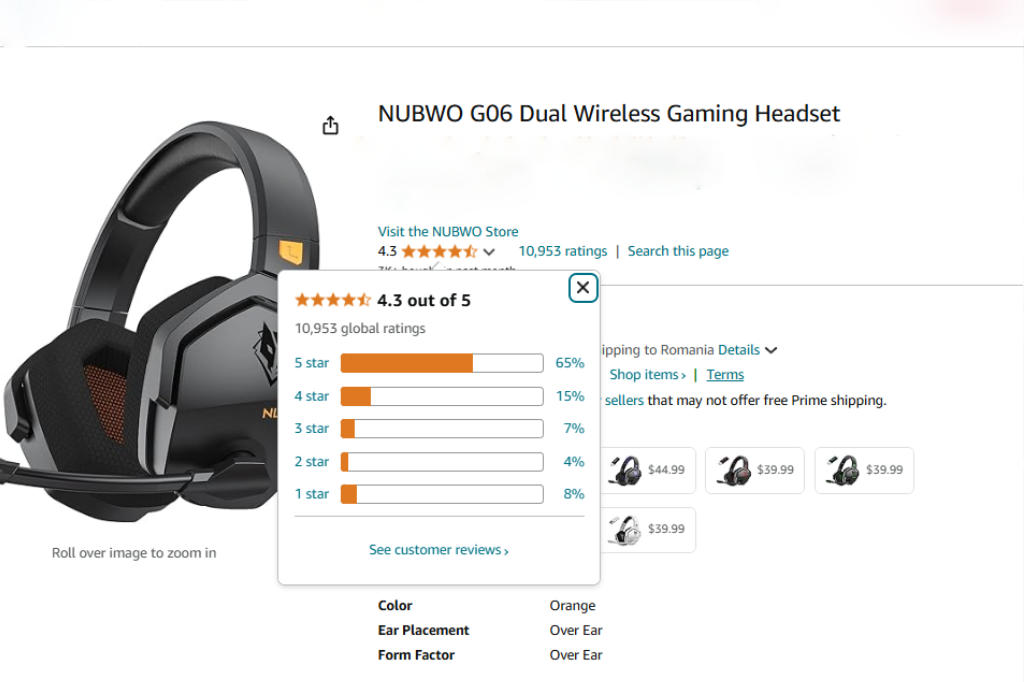The Benefits of Product Page Reviews – from Sales to Amplifying Your eCommerce Marketing Strategy
Surely, we’ve all bought a product because someone else recommended it. Now, imagine bringing that same trust-building experience online. In the digital world, product page reviews do just that – they’re like having a loyal customer right there, backing your next purchase decision. These on-page testimonials not only drive sales but can become a powerful asset in your marketing toolkit. Here’s how to harness these authentic voices to build trust, boost sales, and create an unforgettable shopping experience.
We’re experts in eCommerce development services and we’re here to help you choose the right solution for your business.
Product reviews are important because they offer that needed social proof exactly at the right point – at the point of decision. They are the last and probably most crucial piece of information a potential buyer considers before hitting the ‘Add to Cart’ button. Seeing that others have tried and tested a product gives it the amount of credibility that brand messages alone can’t achieve. For sales, they are the bridge that turns hesitation into commitment better than any polished marketing language ever could.
We can say that Reviews complement, rather than replace, brand marketing messages by adding authenticity to promotional content. While a brand’s messaging introduces and highlights the intended benefits and unique aspects of a product, customer reviews bring these claims to life with personal experiences and honest opinions.
Showing Client Reviews on Product Pages
To maximize their efficiency, client reviews have to be placed strategically on product pages.

Displaying reviews above the fold ensures they are immediately visible without requiring users to scroll. At the same time, highlighting key phrases or keywords within reviews can draw attention to specific product benefits or features, making it easier for potential buyers to identify information relevant to their needs.
Many online stores strategically place star ratings directly below the product name on the page, often accompanied by a link to the full reviews section. This serves as an immediate trust signal, letting shoppers know at a glance how well the product has been received by others. Star ratings provide a quick, visual representation of customer satisfaction. Having them in sight lets shoppers instantly see a product’s quality without scrolling or navigating away from the main product details.
What’s interesting is that, according to various studies done by Statista, products with an average rating between 4.5 and 4.99 stars generate the most traffic and receive the highest number of reviews, indicating that consumers are more inclined to engage with products that have high, yet not perfect, ratings.
Additionally, Verified Buyer badges add an extra layer of credibility by confirming that the feedback comes from customers who have actually purchased the product and the reviews are authentic and not made up.
Refine Your Marketing Messaging with Using Product Reviews
First and foremost, reviews are a goldmine of authentic customer language. A quick scroll through them, and you can easily identify phrases that customers use to describe what they love most about a product. For example, if customers mention the “comfort” of a shoe or the “durability” of a gadget, these attributes can be used in ad copy, product descriptions, or even email marketing campaigns.
Not only will your marketing emails go straight to your clients’ hearts, but you will also benefit from better SEO, as search engines tend to appreciate content that flows naturally and creates better shopping experiences.
Second, these product reviews can be used as social media content in posts, Stories, or Reels. Because they come straight from your customers, it’s likely that they will create a hype around them and a lot of user-generated content. You can also tag the original reviewer (when permissions allow), this way deepening community connections and encouraging more customers to share their experiences.
Last but not least, marketing teams can incorporate reviews into Paid Ads and Newsletters. Reviews add credibility and social proof to the promotional message, driving higher engagement rates. In retargeting ads, featuring snippets from customer reviews can remind past visitors why others love the product, creating a sense of FOMO (fear of missing out) and urgency. Similarly, in newsletters, showing real feedback in the email body might create a stronger impact than a traditional promo message.
Turning Negative Reviews into Marketing Opportunities
Negative reviews are a merchant’s worst nightmare. But let’s be frank, as much as you try to run a perfect business, at one point, things might turn sour. But is it such a bad thing?

Well, if it’s an usual occurrence, you might take drastic actions, but if it’s an isolated mistake, you can easily turn that into an opportunity. In fact, we’re all human, and a mistake, if it’s handled correctly, can have a positive outcome.
First, responding openly and constructively to negative reviews shows potential customers that the brand values feedback and is committed to improvement. If something went wrong, offer refunds, exchanges, or clarifications and these can often turn a dissatisfied customer into a loyal one.
Additionally, criticism in reviews can provide invaluable insights for product improvement and clarity in descriptions.
For example, if several customers mention a product’s sizing is smaller than expected, the brand can adjust the product description to include sizing advice, preventing future misunderstandings.
How to Encourage High-Quality Reviews on Product Pages
In a world where customer attention span is shorter than ever, when ‘rush, rush, rush’ is often what drives us through the day, leaving a lengthy review can be the last thing someone might choose to do with their spare time. That’s why it’s essential to make the review process as straightforward as possible. Consider using a basic star rating system and a short text field for quick comments, followed by optional fields for customers who want to provide more detail. If the process requires a minimal effort, it will increase the likelihood that customers will share their thoughts right after a positive purchase experience.
Part of making the process simple includes having guiding questions, which can help customers organize their thoughts, leading to more structured and valuable reviews.
A good practice is offering incentives for detailed reviews. For instance, brands can enter customers who leave in-depth reviews into a monthly prize draw or offer small discounts on future purchases.
Final Thoughts
As you can see, product reviews are a valuable marketing tool, but to make the most of them, it’s essential to analyze them using the right metrics. Pay close attention to review volume, average ratings, and most importantly – listen to what your customers have to say. Also, consider A/B testing different review display formats – such as star placements, verified badges, or highlighted quotes – to find what resonates best with your audience. By doing these, not only will you boost your sales, but also build trust and enhance the overall shopping experience.
If you want to know more about our list of services at Clever++, please visit our website.




